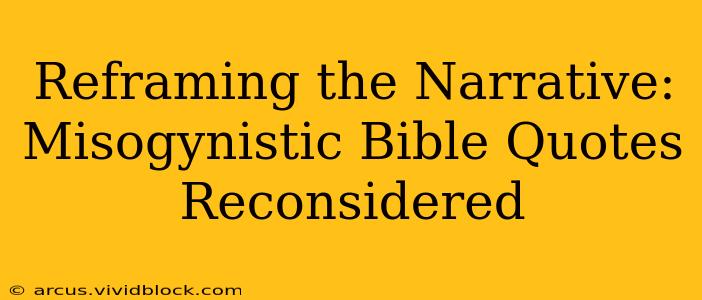The Bible, a cornerstone of faith for billions, contains passages that, when interpreted literally, appear to promote misogyny. These verses have been used to justify patriarchal structures and unequal treatment of women for centuries. However, a deeper, contextualized reading reveals a more nuanced picture, challenging the simplistic labeling of these passages as inherently misogynistic. This article will explore some commonly cited "misogynistic" quotes, examining their historical context, linguistic nuances, and the diverse interpretations offered by scholars across theological traditions. Understanding these complexities allows for a more responsible and informed engagement with scripture, moving beyond superficial readings towards a more just and equitable interpretation.
Are There Truly Misogynistic Verses in the Bible?
This question itself requires careful consideration. The term "misogynistic" implies a deep-seated hatred of women, a sentiment not necessarily reflected in every verse often cited as such. Instead, many passages reflect the cultural norms and societal structures of the time in which they were written. These norms, unfortunately, often involved significant gender inequality. Attributing modern understandings of gender equality to ancient texts is anachronistic and can lead to misinterpretations. The challenge lies in discerning the cultural context while simultaneously engaging with the ethical implications of these passages for contemporary society.
What About the "Headship" Passages? (e.g., Ephesians 5:22-24, 1 Corinthians 11:3)
Passages like Ephesians 5:22-24, instructing wives to submit to their husbands, and 1 Corinthians 11:3, discussing women's head coverings in worship, are frequently highlighted as examples of biblical misogyny. However, interpreting these verses requires understanding the socio-political landscape of the first-century world. The concept of "headship" in these passages is not necessarily about dominance but about mutual submission and complementary roles within a community. Some scholars argue that "headship" reflects a model of ordered society, not inherent male superiority. Others emphasize the importance of understanding the specific cultural practices of the time. Regardless of the interpretation, the critical point is to avoid a literal, decontextualized reading that ignores the historical, social, and cultural setting of these texts.
What About the Stories of Women in the Bible Who Seem to be Subjugated?
The Bible contains numerous narratives of women facing hardship and subjugation. While these stories might seem to validate misogynistic interpretations, it's crucial to note that the Bible also portrays strong, independent, and influential women like Esther, Deborah, and Ruth. Their stories challenge the notion that the Bible uniformly subordinates women. The presence of both narratives of suffering and resilience reflects the complex realities of women's experiences throughout history, and instead of ignoring the complexities, we must wrestle with the varied accounts and the lessons they provide.
Does the Bible Promote Male Dominance?
The question of whether the Bible promotes male dominance is a subject of ongoing debate. While certain interpretations might lead to that conclusion, others emphasize the egalitarian ideals present throughout scripture. For instance, Galatians 3:28 states, "There is neither Jew nor Gentile, neither slave nor free, nor is there male and female, for you are all one in Christ Jesus." This verse, often cited in feminist theology, suggests a vision of equality that transcends gender distinctions. The key is understanding that the Bible is not a monolithic text with a single, unified message. Interpretations vary widely across denominations and theological perspectives.
How Should We Interpret These Challenging Passages?
The interpretation of seemingly misogynistic Bible passages requires careful study, historical context, and critical engagement. It necessitates moving beyond literalism to understand the underlying principles and values. Many scholars advocate for a hermeneutic of suspicion, questioning traditional interpretations and considering alternative perspectives, particularly those that empower marginalized groups. Furthermore, considering the overarching narrative of God’s love, justice, and compassion provides a framework for interpreting these complex passages in a way that aligns with these core values.
Conclusion: Moving Towards a More Equitable Interpretation
The discussion surrounding “misogynistic” Bible quotes necessitates a nuanced and contextualized approach. While acknowledging the historical context and societal norms reflected in these passages is crucial, it’s equally vital to critically examine their application in contemporary society. The aim should be to foster an understanding of the scriptures that promotes justice, equality, and respect for all, regardless of gender. This requires open dialogue, rigorous scholarship, and a commitment to interpreting the Bible in a way that aligns with its core message of love and compassion for all of humanity.

